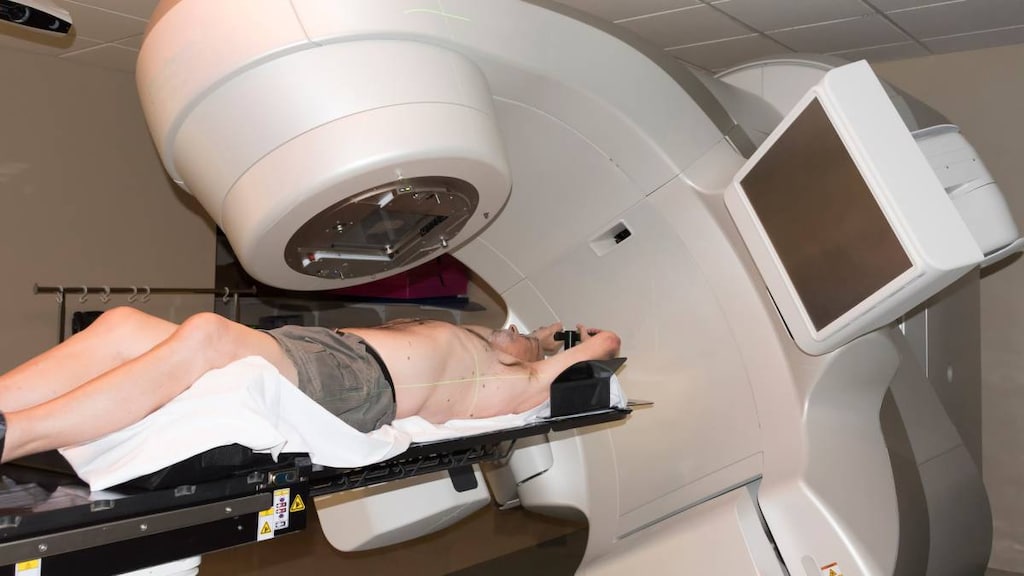Dosage Forms
Excipient information presented when available (limited, particularly for generics); consult specific product labeling.
Solution Reconstituted, Subcutaneous, as acetate:
Firmagon: 80 mg (1 ea); 120 mg (1 ea)
Pharmacology
Mechanism of Action
Gonadotropin-releasing hormone (GnRH) antagonist which reversibly binds to GnRH receptors in the anterior pituitary gland, blocking the receptor and decreasing secretion of luteinizing hormone (LH) and follicle stimulation hormone (FSH), resulting in rapid androgen deprivation by decreasing testosterone production, thereby decreasing testosterone levels. Testosterone levels do not exhibit an initial surge, or flare, as is typical with GnRH agonists (Crawford 2011).
Pharmacokinetics/Pharmacodynamics
Distribution
Vd: >1000 L
Metabolism
Hepatobiliary, via peptide hydrolysis
Excretion
Feces (~70% to 80%, primarily as peptide fragments); urine (~20% to 30%)
Onset of Action
Rapid; ~96% of patients had testosterone levels ≤50 ng/dL within 3 days (Klotz 2008)
Time to Peak
Plasma: Loading dose: SubQ: Within 2 days
Half-Life Elimination
Loading dose: SubQ: ~53 days; Maintenance dose: SubQ: ~31 days (Canadian labeling)
Protein Binding
~90%
Use in Specific Populations
Special Populations: Hepatic Function Impairment
A single dose of degarelix 1 mg was administered intravenously to subjects without prostate cancer with mild (Child Pugh class A) or moderate (Child Pugh class B) impairment; degarelix exposure was decreased 10% for mild impairment, and 18% for moderate impairment (when compared to patients without prostate cancer and with normal hepatic function).
Use: Labeled Indications
Prostate cancer, advanced: Treatment of advanced prostate cancer
Contraindications
Known hypersensitivity to degarelix or any component of the formulation; women who are or may become pregnant.
Documentation of allergenic cross-reactivity for drugs in this class is limited. However, because of similarities in chemical structure and/or pharmacologic actions, the possibility of cross-sensitivity can not be ruled out with certainty.
Dosage and Administration
Dosing: Adult
Prostate cancer, advanced: SubQ:
Loading dose: 240 mg administered as two 120 mg (3 mL) injections
Maintenance dose: 80 mg administered as one 4 mL injection every 28 days (beginning 28 days after initial loading dose)
Dosing: Geriatric
Refer to adult dosing.
Reconstitution
Wear gloves for preparation and administration. Reconstitute with provided prefilled syringe containing preservative free sterile water for injection (reconstitute each 120 mg vial with 3 mL; reconstitute the 80 mg vial with 4.2 mL). Swirl gently; do NOT shake (to prevent foaming). Dissolution usually takes a few minutes, although may take up to 15 minutes. May tilt the vial slightly if the powder adheres to the side of the vial. To withdraw for administration, turn the vial completely upside down and pull down on the plunger to withdraw all of the reconstituted solution from the vial to the syringe; expel all air bubbles. Administer within 1 hour (US labeling) or 2 hours (Canadian labeling, although immediate administration is preferred) of reconstitution. Use of concentrations other than those described in the manufacturer’s labeling is not recommended.
Administration
SubQ: Administer (deep) SubQ in the abdominal area by pinching skin and elevating SubQ tissue; insert needle at a 45 degree angle. Gently pull plunger back to check for aspiration (if blood is aspirated into syringe, do not inject; discard and reconstitute a new dose); slowly inject over 30 seconds, remove needle and then release skin. For SubQ administration only; do not inject into a vein or into muscle. Avoid pressure exposed areas (eg, waistband, belt, or near ribs). Rotate injection site. Inject loading dose as two 3 mL injections (40 mg/mL) in different sites; maintenance dose should be administered as a single 4 mL injection (20 mg/mL); begin maintenance dose 28 days after initial loading dose.
Storage
Store at 25°C (77°F); excursions permitted to 15°C to 30°C (59°F to 86°F). Use within 1 hour of reconstitution (US labeling). The Canadian labeling recommends immediate administration following reconstitution (preferred); stability has been demonstrated for 2 hours following reconstitution. Do not shake the vials.
Drug Interactions
Haloperidol: QT-prolonging Agents (Indeterminate Risk - Caution) may enhance the QTc-prolonging effect of Haloperidol. Monitor therapy
Indium 111 Capromab Pendetide: Antigonadotropic Agents may diminish the diagnostic effect of Indium 111 Capromab Pendetide. Avoid combination
QT-prolonging Agents (Highest Risk): QT-prolonging Agents (Indeterminate Risk - Caution) may enhance the QTc-prolonging effect of QT-prolonging Agents (Highest Risk). Management: Monitor for QTc interval prolongation and ventricular arrhythmias when these agents are combined. Patients with additional risk factors for QTc prolongation may be at even higher risk. Monitor therapy
Test Interactions
Suppression of pituitary-gonadal function may affect diagnostic tests of pituitary gonadotropic and gonadal functions.
Adverse Reactions
>10%:
Central nervous system: Fatigue (3% to ≥10%)
Endocrine & metabolic: Hot flash (26%), increased gamma-glutamyl transferase (≥10%), weight loss (≥10%), weight gain (9% to ≥10%)
Hepatic: Increased serum transaminases (47%)
Local: Injection site reactions (35%, grade 3: ≤2%; pain at injection site [28%], erythema at injection site [17%], swelling at injection site [6%], induration at injection site [4%], injection site nodule [3%], injection site infection [including abscess, 1%])
Miscellaneous: Fever (1% to ≥10%)
1% to 10%:
Cardiovascular: Hypertension (6%)
Central nervous system: Chills (5%), dizziness (1% to 5%), headache (1% to 5%), insomnia (1% to 5%)
Dermatologic: Diaphoresis
Endocrine & metabolic: Hypercholesterolemia (3%), gynecomastia
Gastrointestinal: Constipation (5%), nausea (1% to 5%), diarrhea
Genitourinary: Urinary tract infection (5%), erectile dysfunction, testicular atrophy
Hepatic: Increased serum ALT (10%; grade 3: <1%), increased serum AST (5%; grade 3: <1%)
Immunologic: Antibody development (antidegarelix: 10%)
Neuromuscular & skeletal: Back pain (6%), arthralgia (5%), weakness (1% to 5%)
Miscellaneous: Night sweats (1% to 5%)
<1%, postmarketing, and/or case reports: Bone metastases (worsening), cerebrovascular accident, depression, hypersensitivity reaction (including anaphylaxis, urticaria, and angioedema), itching at injection site, local soreness/soreness at injection site, malignant lymphoma, mental status changes, myocardial infarction, osteoarthritis, prolonged Q-T interval on ECG, squamous cell carcinoma, unstable angina pectoris
Warnings/Precautions
Concerns related to adverse effects:
- Anemia: Testosterone suppression is associated with the development of anemia.
- Decreased bone mineral density: Androgen deprivation therapy is associated with decreased bone mineral density.
- Hypersensitivity: Hypersensitivity reactions (including anaphylaxis, urticaria, and angioedema) have been reported. Discontinue for serious hypersensitivity reaction (immediately if dose not fully injected); manage hypersensitivity as clinically indicated. Do not rechallenge after serious hypersensitivity reaction.
- QT prolongation: Androgen deprivation therapy may prolong the QT interval. Use with caution in patients with congenital long QT syndrome, known history of QT prolongation, or other risk factors for QT prolongation (eg, concomitant use of medications known to prolong QT interval, heart failure, and/or electrolyte abnormalities). Consider periodic electrolyte and ECG monitoring.
Disease-related concerns:
- Cardiovascular disease: Androgen-deprivation therapy may increase the risk for cardiovascular disease (Levine 2010).
- Diabetes: Androgen deprivation therapy may be associated with an increased risk for insulin resistance and diabetes (Keating 2006).
- Hepatic impairment: Degarelix exposure is decreased in patients with hepatic impairment, dosage adjustment is not recommended in patients with mild to moderate hepatic impairment, although testosterone levels should be monitored. Has not been studied in patients with severe hepatic impairment; use with caution. Mild transient increases in transaminases have been observed; monitor liver function in patients with known or suspected hepatic disorder.
- Renal impairment: Data for use in patients with moderate to severe renal impairment (CrCl <50 mL/minute) is limited; use with caution.
Concurrent drug therapy issues:
- Drug-drug interactions: Potentially significant interactions may exist, requiring dose or frequency adjustment, additional monitoring, and/or selection of alternative therapy. Consult drug interactions database for more detailed information.
Monitoring Parameters
Prostate-specific antigen (PSA) periodically, serum testosterone levels (if PSA increases; in patients with hepatic impairment: monitor testosterone levels monthly until achieve castration levels, then consider monitoring every other month), liver function tests (at baseline); consider baseline and periodic monitoring of serum electrolytes (calcium, magnesium, potassium, sodium); bone mineral density; consider baseline and periodic ECG monitoring.
Screen for diabetes and cardiovascular risk (blood pressure, lipid profile, serum glucose) prior to initiating treatment and 3 to 6 months after initiation (Levine 2010).
Pregnancy
Pregnancy Risk Factor
X
Pregnancy Considerations
Use is contraindicated in women who are or may become pregnant.
Adverse events were observed in animal reproduction studies.
Patient Education
What is this drug used for?
- It is used to treat prostate cancer.
- It may be given to you for other reasons. Talk with the doctor.
Frequently reported side effects of this drug
- Weight gain
- Constipation
- Sexual dysfunction
- Decreased sex drive
- Loss of strength and energy
- Hot flashes
- Back pain
- Joint pain
- Chills
- Injection site redness, swelling, pain, or itching
Other side effects of this drug: Talk with your doctor right away if you have any of these signs of:
- Fast heartbeat
- Abnormal heartbeat
- Severe headache
- Severe dizziness
- Passing out
- Vision changes
- Urinary tract infection like blood in the urine, burning or painful urination, passing a lot of urine, fever, lower abdominal pain, or pelvic pain.
- Bone pain
- Signs of a significant reaction like wheezing; chest tightness; fever; itching; bad cough; blue skin color; seizures; or swelling of face, lips, tongue, or throat.
Note: This is not a comprehensive list of all side effects. Talk to your doctor if you have questions.
Consumer Information Use and Disclaimer: This information should not be used to decide whether or not to take this medicine or any other medicine. Only the healthcare provider has the knowledge and training to decide which medicines are right for a specific patient. This information does not endorse any medicine as safe, effective, or approved for treating any patient or health condition. This is only a brief summary of general information about this medicine. It does NOT include all information about the possible uses, directions, warnings, precautions, interactions, adverse effects, or risks that may apply to this medicine. This information is not specific medical advice and does not replace information you receive from the healthcare provider. You must talk with the healthcare provider for complete information about the risks and benefits of using this medicine.




